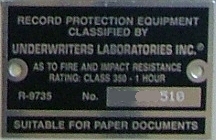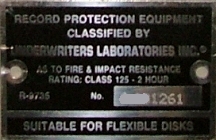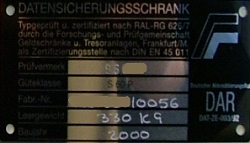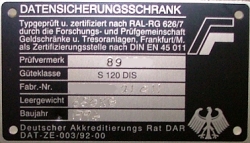HOW CABINETS ARE FIRE TESTED
A cabinet's ability to withstand a fire is tested by an independant body and ultimately falls into 2 categories and then 3 classes within.
The cabinet is built either to store paper documents or computer media such as EDP media (magnetic tapes), computer diskettes (floppy disks), CDs/DVDs etc.
It must be understood that Record Protection Cabinets and Data Media Cabinets are very different. Whilst intrinsically they do the same thing, protect your valuable data from fire and pilferage, they are built to different specifications.
Paper will char or start to combust at 170°C (405°F) whereas Magnetic Media will be rendered useless at the much lower temperature of 52°C (125°F). Therefore, the cabinets are built to keep their respective specific contents below these critical temperatures.
Additionally, a Data Media Cabinet will protect its contents from exposure to other damaging elements, such as: smoke gases, dust, magnetic fields, electrostatics and humidity.
Once tested, a cabinet is then awarded a certificate with a 60, 90 or 120 minute rating.
So you, the consumer, will know which particular cabinet has which award, it will carry an identifying label. For instance, UL Class 350 2H.
This would tell you the cabinet has been certificated by the Underwriters Laboratory of Chicago and is suitable for paper document storage with a protection period of 2 hours. The 350 signifies the cabinet's internal temperature never exceeds 350°F through the duration of the test.
  
Another example of a test label is VDMA's S120 DIS. This type of label shows a cabinet is suitable for all types of computer media storage and it has a 2 hour protection period.
Generally, when you see a label it will have a suffix of either a P or Paper showing the cabinet is suitable for Paper Document Storage or a D or DIS (disk) showing the cabinet is suitable for Magnetic and Computer Media Storage.
The exception to this is the UL label which is shown as the temperature the cabinet must not exceed. UL Class 350, the internal temperature never exceeds 350°F so suitable for Paper Document Storage or UL Class 125, the internal temperature never exceeds 125°F so suitable for Magnetic and Computer Media Storage.
  
 Modern fire resistant cabinets offer far more protection than their predecessors. Modern fire resistant cabinets offer far more protection than their predecessors.
Todays standard of testing is very high and a cabinet must go through several stages before one of the testing bodies will award a certificate.
Standards such as the Nordtest NT FIRE 017 and UL 72 set very strict criteria, eg:
The cabinet is placed into a furnace and has to withstand temperatures of over
1000°C for up to 2 hours, depending on the classification.
It is then allowed to cool within the furnace, to simulate the after effect of a real fire. All the time this is happening, the interior temperature must not rise above 170°C for a record protection cabinet or 52°C for a data media cabinet.
After the slow cool, the cabinet is then drop tested. It will be hoisted 30 foot, dropped onto a stone bed, inverted and then returned to the furnace to see it maintains an internal temperature below the specified limits.
The drop test simulates the cabinet falling through an upper floor, should the integrity of the floor be undermined by a fire.
Another test a cabinet may go through is the Explosive Test. This entails the unit being exposed to a flash fire with a temperature as high as 1093°C (2000°F) for a period of 20 minutes. During the fire, the unit must not explode or rupture.
The independant bodies that carry out the testing are usually one of the following:
To learn more about European Safety Standards and Certification, visit:

| 
